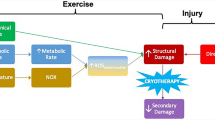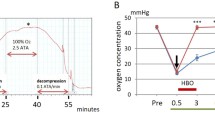Abstract
Current evidence suggests that popular alternative therapies such as massage, cryotherapy, and hyperbaric oxygen exposure as currently practiced on humans have little effect on recovery from minor muscle damage such as induced by exercise. While further research is still needed, hyperbaric oxygen exposure shows clear promise for potentially being a successful adjunct treatment for enhancing muscle repair and recovery from more severe crush on contusion injury in humans. Cryotherapy or icing, as currently practiced, will not likely be successful in cooling muscle sufficiently to have any significant influence on muscle repair regardless of the degree of injury. However, based on studies in animal models, it may be that if sufficient muscle cooling could be achieved in humans, it could actually delay recovery and increase muscle scarring following significant muscle damage. Conclusions about the effectiveness of massage on influencing muscle recovery from more severe injury cannot yet be made due to a lack of experimental evidence with a more significant muscle damage model.
Similar content being viewed by others
References
Papers of particular interest, published recently, have been highlighted as: • Of importance •• Of major importance
Hyldahl RD, Hubal MJ. Lengthening our perspective: morphological, cellular and molecular responses to eccentric exercise. Muscle Nerve. 2013;49:155–70.
Jarvinen AH, Jarvinen TLN, Kaarianen M, Kalimo H, Jarvinen M. Muscle injuries biology and treatment. Am J Sports Med. 2005;33:745–64.
Delos D, Maak TG, Rodeo SA. Muscle injury in athletes: enhancing recovery through scientific understanding and novel therapies. Sports Health. 2013;5:346–52.
Tiidus PM. Skeletal muscle damage and repair. Champaign IL: Human Kinetics Pub; 2007.
Barnes PM, Bloom B, Nahin RL. Complementary and alternative medicine use among adults and children: United States, 2007. Natl Health Stat Rep. 2008;12:1–23.
Tiidus PM. Massage Therapy in Tiidus PM ed. Skeletal muscle damage and repair. Human Kinetics Pub. Champaign IL. 2007 pp. 195–202
Torres R, Riberio F, Duarte JA, Cabri JMH. Evidence of the physiotherapeutic interventions used currently after exercise-induced muscle damage: systematic review and meta-analysis. Phys Ther Sports. 2011;13:101–14.
Weerapong P, Hume PA, Kolt GS. The mechanisms of massage and effects on performance, muscle recovery and injury prevention. Sports Med. 2005;35:235–56.
Zainuddin Z, Newton M, Sacco P, Nosaka K. Effects of massage on delayed-onset muscle soreness, swelling and recovery of muscle function. J Athl Train. 2005;40:174–80.
Warren GL, Lowe DA, Armstrong RB. Measurement tools used in the study of eccentric contraction-induced muscle injury. Sports Med. 1999;27:43–59.
Tiidus PM, Shoemaker JK. Effleurage massage, muscle blood flow and long term post-exercise strength recovery. Int J Sports Med. 1995;16:478–83.
Jonhagen S, Ackermann P, Eriksson T, Saartok T, Renstrom PA. Sports massage after eccentric exercise. Am J Sports Med. 2004;32:1499–503.
Tiidus PM. Massage and ultrasound as therapeutic modalities in exercise-induced muscle damage. Can J Appl Physiol. 1999;24:267–98.
Tiidus PM. Manual massage and recovery of muscle function following exercise: a literature review. J Orthop Sports Phys Ther. 1997;25:107–12.
Haas C, Butterfield TA, Abshire S, Zhao Y, Zhang X, Jarjoura D, et al. Massage timing affects postexercise muscle recovery and inflammation in a rabbit model. Med Sci Sports Exerc. 2013;45:1105–12.
Haas C, Butterfield TA, Zhao Y, Zhang X, Jarjoura D, Best TM. Dose-dependency of massage-like compressive loading on recovery of active muscle properties following eccentric exercise: rabbit study with clinical relevance. Br J Sports Med. 2013;47:83–8.
Haas C, Best TM, Wang Q, Butterfield TA, Zhao Y. In vivo passive mechanical properties of skeletal muscle improve with massage-like loading following eccentric exercise. J Biomech. 2012;45:2630–6.
Butterfield TA, Zhao Y, Agarwal S, Haq F, Best TM. Cyclic compressive loading facilitates recovery after eccentric exercise. Med Sci Sports Exerc. 2008;40:1289–96.
Crane JD, Ogborn DI, Cupido C, Melov S, Hubbard A, Bourgeois JM, et al. Massage therapy attenuates inflammatory signaling after exercise-induced muscle damage. Sci Trans Med. 2012;4:119ra13. Interesting study which highlights some of the effects massage may have on inflammatory signaling in human muscle.
Wiltshire EV, Poitras V, Pak M, Hong T, Rayner J, Tschakovsky ME. Massage impairs postexercise muscle blood flow and “lactic acid” removal. Med Sci Sports Exerc. 2010;42:1062–71.
Shoemaker JK, Tiidus PM, Mader R. Failure of manual massage to alter limb blood flow: measures by Doppler ultrasound. Med Sci Sports Exerc. 1999;29:610–4.
Bleakley CM, Glasgow P, Webb MJ. Cooling an acute muscle injury: can basic scientific theory translate into the clinical setting? Br J Sports Med. 2012;46:296–8.
Schaster KD, Disch AC, Stover JF, Lauffer A, Bail HJ, Mittlmeier T. Prolonged superficial local cryotherapy attenuates microcirculatory impairment, regional inflammation, and muscle necrosis after closed soft tissue injury in rats. Am J Sports Med. 2007;35:93–102.
Takagi R, Fujita N, Arakawa T, Kawada S, Ishii N, Miki A. Influence of icing on muscle regeneration after crush injury to skeletal muscle in rats. J Appl Physiol. 2011;110:382–8. Important study which highlights the potential longer term negative influence of cryotherapy on muscle regeneration following crush injury.
Howatson G, Gaze D, van Someren KA. Efficacy of ice massage in the treatment of exercise-induced muscle damage. Scan J Med Sci Sports. 2005;15:416–22.
Crystal NJ, Townson DH, Cook SB, LaRoche DP. Effect of cryotherapy on muscle recovery and inflammation following a bout of damaging exercise. Eur J Appl Physiol. 2013;113:2577–86.
Bennett MH, Best TM, Babul-Wellar S, Taunton JE. Hyperbaric oxygen therapy for delayed muscle soreness and closed soft tissue injury. Cochrane Rev. 2005;4:CD004713.
Strauss MB. The effect of hyperbaric oxygen in crush injuries and skeletal muscle-compartment syndromes. Undersea Hyperb Med. 2012;39:847–55.
Kanhai A, Losito JM. Hyperbaric oxygen therapy for lower-extremity soft-tissue injuries. J Am Podiatr Med Asssoc. 2003;93:298–306.
Tiidus PM. Hyperbaric oxygen and drug therapies. In: Tiidus PM, editor. Skeletal muscle damage and repair. Champaign IL: Human Kinetics Pub; 2007. p. 257–61.
Gregorevic P, Lynch GS, Williams DA. Hyperbaric oxygen improves contractile function of regenerating rat skeletal muscle after myotoxic injury. J Appl Physiol. 2000;89:1477–82.
Babul S, Rhodes EC, Taunton JE, Lepawski M. Effects of intermittent exposure of hyperbaric oxygen for the treatment of an acute soft tissue injury. Clin J Sports Med. 2004;13:138–47.
Horie M, Enomoto M, Shimoda M, Okawa A, Miyakawa S, Yagishita K. Enhancement of satellite cell differentiation and functional recovery in injured skeletal muscle by hyperbaric oxygen treatment. J Appl Physiol. 2014;116:149–55. Important recent study which highlights the potential enhancing effects of hyperbaric oxygen therapy for enhancing muscle satellite cell responses and recovery following injury.
Majmundar AJ, Skuli N, Mesquita C, Kim MN, Yodh AG, Nguyen-McCarty M, et al. O2 regulates skeletal muscle progenitor differentiation through phosphatidylinositol 3-kinase/AKT signaling. Mol Cell Biol. 2012;32:36–49.
Yamada N, Toyoda I, Doi T, Kumada K, Kato H, Yoshida S, Shirai K, Kanda N, Ogura S. Hyperbaric oxygenation therapy for crush injuries reduces the risk of complications: research report. 2014;41:283–289
Compliance with Ethics Guidelines
Conflict of Interest
Peter M. Tiidus declares that he has no conflict of interest.
Human and Animal Rights and Informed Consent
This article does not contain any studies with human or animal subjects performed by any of the authors.
Author information
Authors and Affiliations
Corresponding author
Additional information
This article is part of the Topical Collection on Muscle Injuries
Rights and permissions
About this article
Cite this article
Tiidus, P.M. Alternative treatments for muscle injury: massage, cryotherapy, and hyperbaric oxygen. Curr Rev Musculoskelet Med 8, 162–167 (2015). https://doi.org/10.1007/s12178-015-9261-3
Published:
Issue Date:
DOI: https://doi.org/10.1007/s12178-015-9261-3




